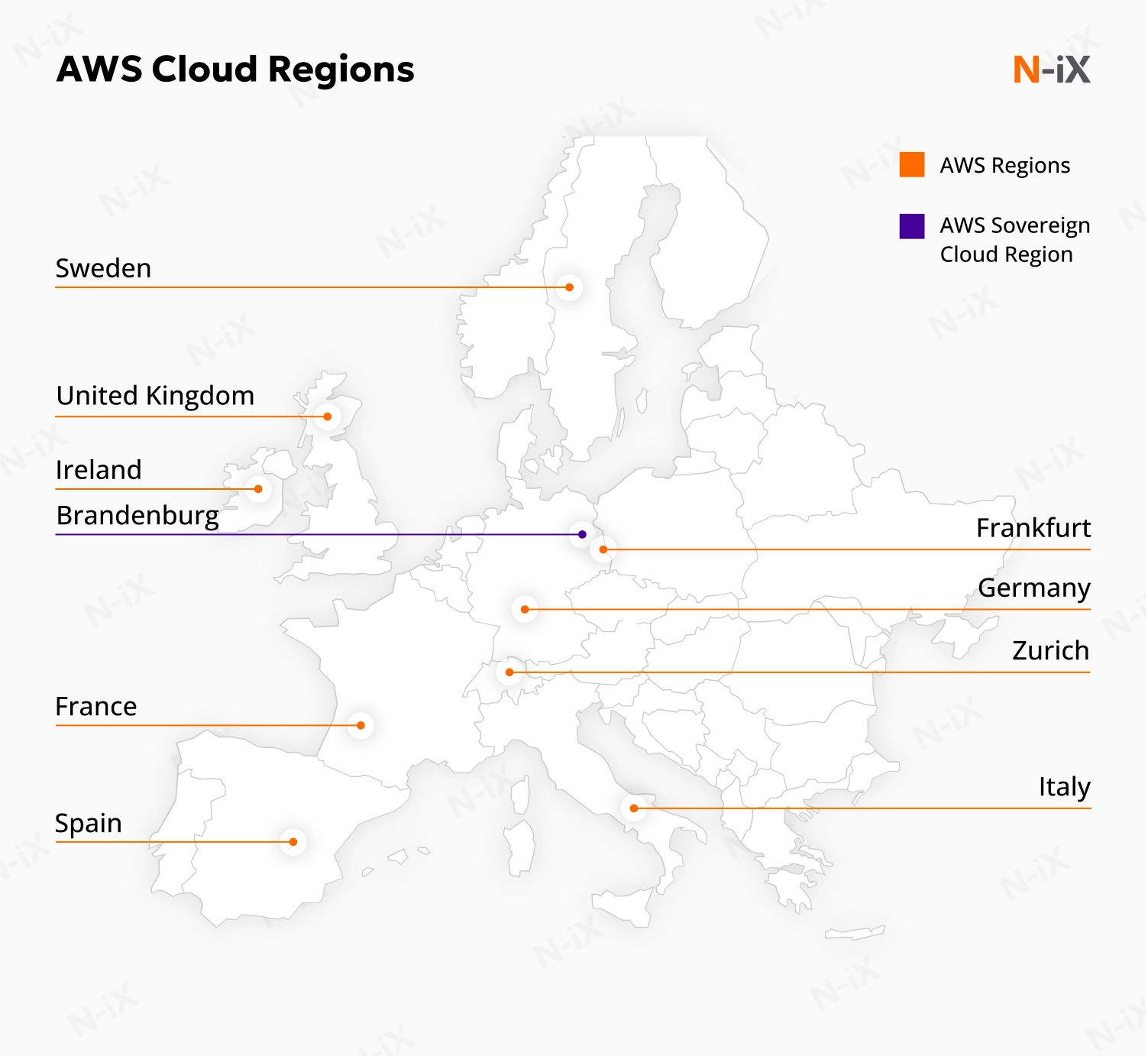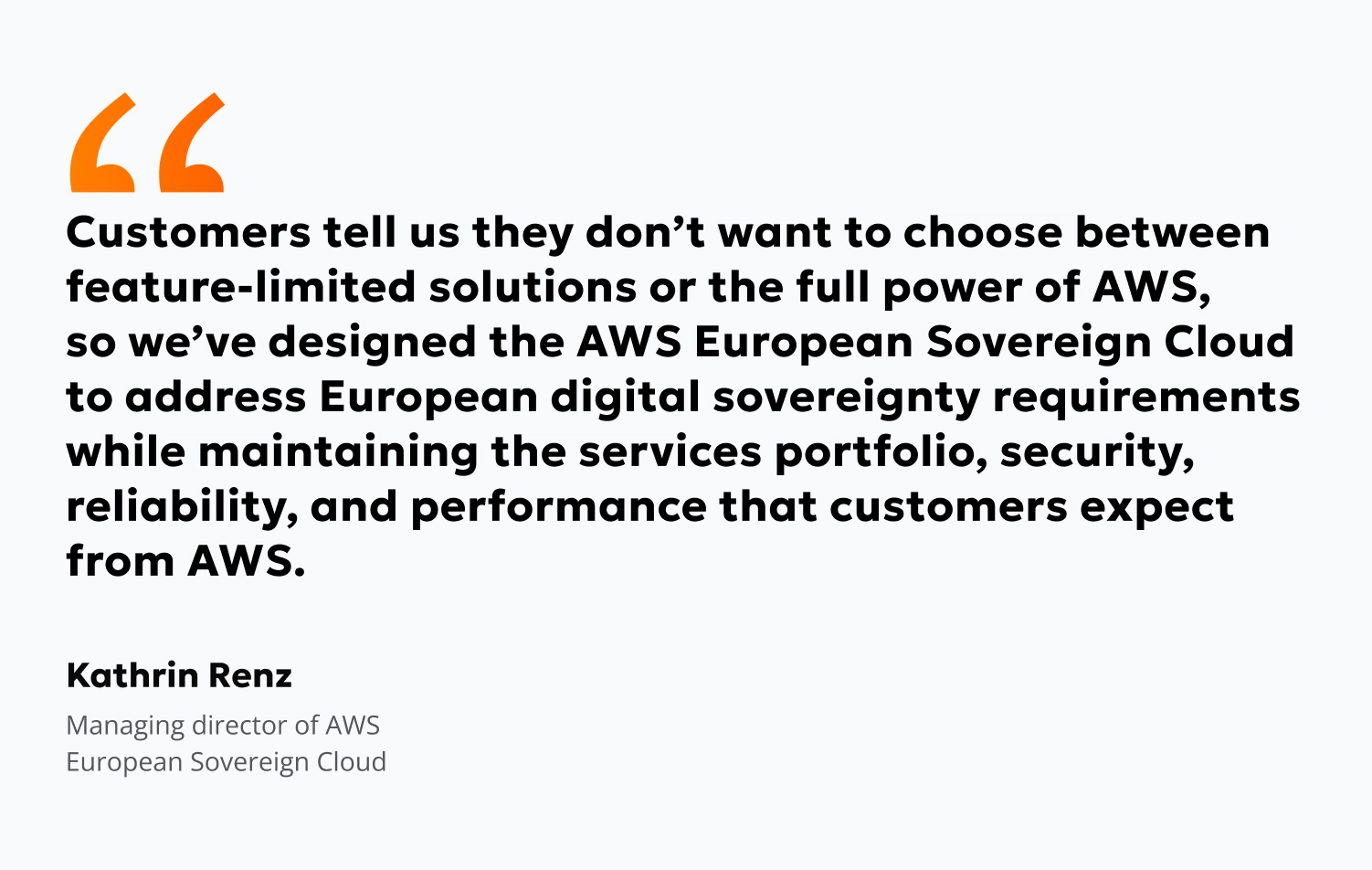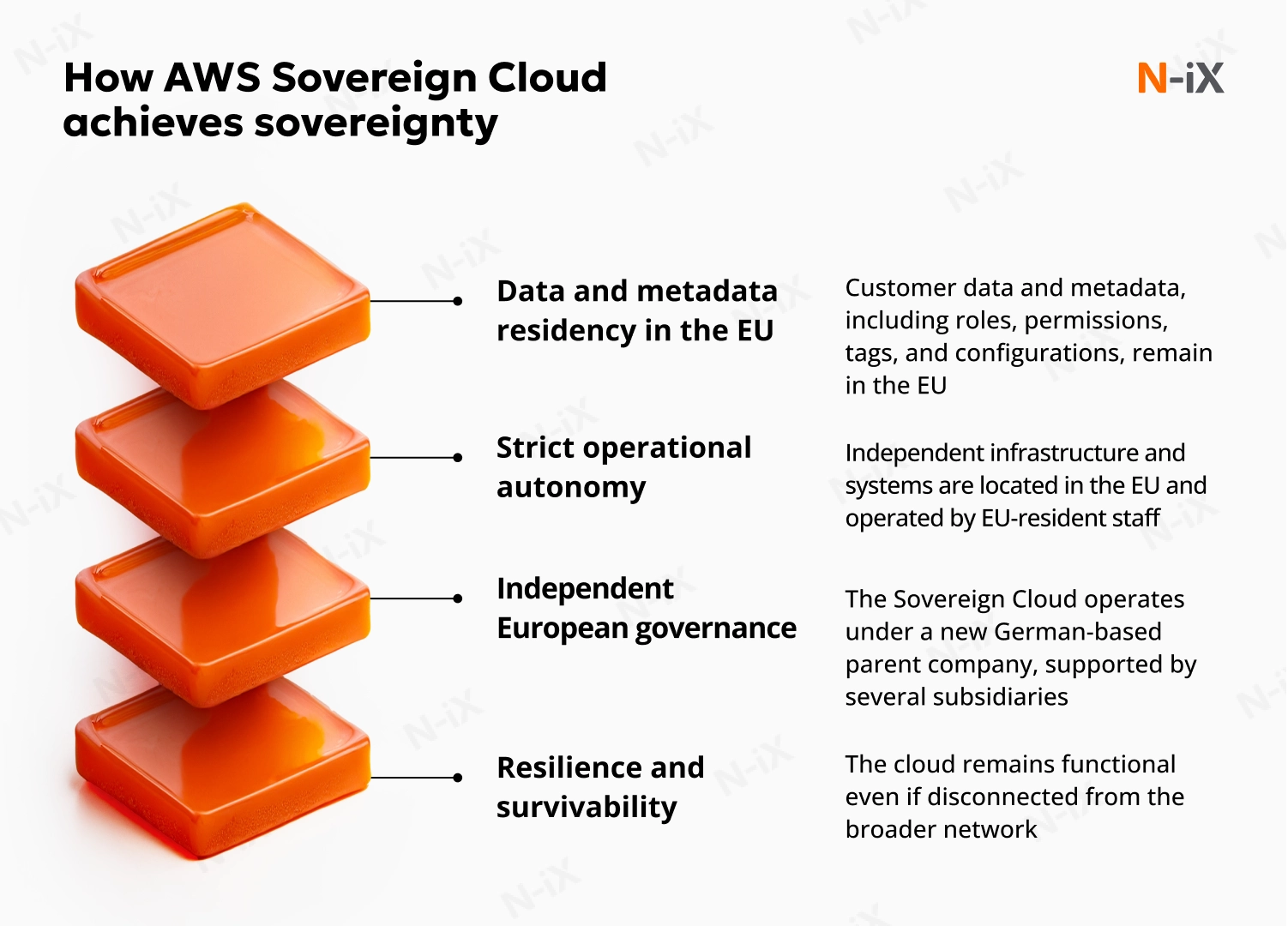In May 2024, Amazon announced its plan to invest €7.8B in the AWS European Sovereign Cloud through 2040. Rising regulatory scrutiny and the need for control over digital assets hosted on US-based hyperscalers have put pressure on organizations across Europe. In response, AWS has prepared to launch the first sovereign cloud region by the end of 2025. The new offering combines AWS services with independent European oversight, giving organizations stronger operational control over their cloud solutions.
In this article, we’ll break down the new Sovereign Cloud offering. Explore our guide to discover how it provides sovereignty, which organizations need it, and how to get started.

What is the AWS Sovereign Cloud?
AWS has long provided options, such as AWS Regions, that let organizations control the location of their compute resources and data. But satisfying data residency is only one part of what sovereignty demands. A sovereign cloud is not just about geography. It also defines who has access to your data and infrastructure, which jurisdiction governs them, and how operations are controlled. The AWS European Sovereign Cloud is built to meet these requirements.
This offering will serve as a new, independent cloud environment for Europe, with its first Sovereign Region launching in Brandenburg, Germany. It’s designed to be physically and logically separate from existing AWS Regions, with all operations and support managed by EU-resident staff under EU law. Amazon also reveals that it’s not going to be a scaled-down environment. Customers will still find the familiar AWS architecture, a broad portfolio of services (including AI/ML tools like Amazon SageMaker and Bedrock), and APIs that they already use.
Sovereign-by-design infrastructure helps organizations prepare for what comes next, from new AI regulations to security standards and regional laws, while continuing to innovate. It’s about building governance that evolves with technology and business ambition.
Who will benefit from the new cloud the most?
Public sector organizations and highly regulated industries may find the most use cases. These include finance, healthcare, critical infrastructure, and similar domains, as they face the strictest requirements for data residency, operational control, and resilience.
Let’s explore how the new Sovereign Cloud compares to existing AWS options to better understand its unique advantages.
Traditional AWS options vs the Sovereign Cloud
Besides the sovereign platform, AWS offers two main infrastructure types:
-
AWS Regions
As of 2025, AWS operates eight Regions in Europe: Ireland, the UK, Italy, France, Sweden, Spain, and two regions in Germany. These Regions allow customers to keep data within specific geographies, offering the first layer of data residency control. Still, unlike the sovereign option, they don’t ensure operational autonomy and governance under local European jurisdiction.
Best for: Workloads where geographic data residency is the primary requirement.
-
AWS Dedicated Local Zones
Dedicated Local Zones are AWS deployments used by a single customer or community. They can be placed in a location that a customer chooses, staffed by local AWS personnel, and configured to support workloads with specific regulatory needs. Before the Sovereign Cloud existed, Dedicated Local Zones had been linked to AWS Regions without providing full operational autonomy. Now, the Sovereign Cloud will function as one of the parent regions for Dedicated Local Zones.
Best for: Organizations running highly sensitive or classified workloads that require dedicated infrastructure but not complete operational separation.

The European Sovereign Cloud offers a more comprehensive response to sovereignty concerns. In the next section, we’ll look more closely at the characteristics that set it apart.
Key features of the AWS European Sovereign Cloud
The new AWS EU Sovereign Cloud aims to create an environment that goes beyond compliance. Our experts break down the factors that make independent operations and governance possible.
Complete EU data and metadata residency
Unlike standard AWS Regions, the sovereign offering ensures that not only customer data but also metadata remains entirely within the EU. Metadata includes roles, permissions, tags, and system configurations. By designing infrastructure fully contained in Europe, AWS gives organizations confidence that every layer of their environment remains under local EU jurisdiction.
Read more: Data sovereignty: What does compliance require in 2026?
Strict operational autonomy
AWS achieves operational autonomy by ensuring all critical aspects of the cloud are managed within Europe and under local control. The main elements contributing to this autonomy include:
- Personnel: Operations and support are handled exclusively by EU residents located in the EU. This applies to all day-to-day operations, including data center access, technical support, and customer service.
- Infrastructure: Infrastructure is physically and logically separate, with no critical dependencies on non-EU systems. All other essential elements for operation, including staff, technology, and leadership, are also based in Europe.
- Systems: The Sovereign Cloud introduces fully independent billing and usage tracking systems, requiring customers to create new accounts distinct from existing AWS ones.
- Networking: The cloud uses dedicated networking from European providers and its own DNS infrastructure with European top-level domains.
Independent European governance
The AWS Sovereign Cloud will operate under an independent governance structure controlled within the EU. A new German-based parent company, supported by several subsidiaries, will oversee all operations. The management team is represented by German nationals and EU citizens residing in the EU. The team will be responsible for ensuring compliance with European laws and sovereignty requirements.
Also, to strengthen accountability, an independent advisory board will provide guidance on security, privacy, and sovereignty-related matters.
Resilience and survivability
Resilience is a core principle of the new Sovereign Cloud, designed to keep the environment running even if disconnected from the broader network. This is achieved through the standard AWS architecture of multiple Availability Zones (AZs), each providing independent power, cooling, and networking. In critical situations, authorized EU-resident personnel can access a replica of the source code needed to maintain the services, ensuring operational continuity.

How can organizations get started with the AWS European Sovereign Cloud?
While the Sovereign Cloud by AWS brings significant opportunities, it also raises practical questions. How should you prepare for AWS migration if you already run workloads in the cloud? Is it better to wait until AWS launches more sovereign regions, or can you begin development now? Our experts address these questions and provide several essential tips to help you adopt the Sovereign Cloud effectively.
1. Plan ahead
First of all, you don’t need to wait until all sovereign regions are launched to begin. AWS encourages customers to start building applications today in any of the eight existing European AWS Regions. By designing your applications with a migration strategy in mind, you can innovate now and move relevant workloads to the AWS EU Sovereign Cloud later with minimal disruption.
2. Partner with cloud consultants
Meeting the requirements of digital sovereignty, from strict data residency to operational control, can be complicated. By partnering with experienced AWS developers, you ensure your organization navigates these challenges efficiently while minimizing risk. An expert partner can help design and configure systems that meet compliance standards, optimize workflows, and align the Sovereign Cloud deployment with your business goals.
As an AWS Premier Tier Services Partner with deep expertise in cloud migration, infrastructure management, compliance, and security, N-iX provides cloud guidance tailored to your organization’s needs.
Discover more facts and insights in our guide to cloud consulting in Europe
3. Assess your workloads for a multi-cloud approach
Our experts note that an organization’s workloads may require different levels of isolation and compliance. Conducting a detailed cloud assessment helps identify which applications require full sovereignty and which can remain on other cloud platforms. In some cases, a multi-cloud approach can optimize costs and maintain access to capabilities not yet available in the AWS European Sovereign Cloud.
4. Implement encryption and access controls
Controlling access to data is a critical part of digital sovereignty. The European Sovereign Cloud AWS provides tools to protect sensitive information and ensure only authorized personnel can access it. Consider implementing the following:
- Encryption of data at rest, in transit, and in memory;
- AWS Key Management Service (KMS) for customer-managed keys;
- AWS KMS External Key Store for external key management;
- AWS Nitro System for strong hardware-based isolation.
These measures help organizations secure sensitive workloads while maintaining complete operational control.
5. Practice utilizing data residency guardrails
Gain practical experience with data residency controls by using existing AWS services. AWS Control Tower provides a specific category of controls for digital sovereignty. You can already use these guardrails to enforce policies that prevent data from being stored or processed outside of your chosen AWS Regions. This helps your team establish disciplined operational practices, making the future data migration to the Sovereign Cloud much easier.
Some organizations also wonder whether they should migrate all their workloads to the Sovereign Cloud. While Amazon commits to protecting European businesses’ data in their AWS Digital Sovereignty Pledge, there is still an ongoing debate whether any US-based hyperscaler can guarantee sovereignty. This is largely driven by the US CLOUD Act, which allows American authorities to request data stored abroad by US-based providers. Let’s discuss how to approach such concerns.
Multi-cloud as a solution for legislation concerns
Our cloud experts note that for many organizations, confidence in legal autonomy comes from a layered approach. While the Sovereign Cloud offers new opportunities, you don’t have to rely on a single infrastructure option—or even provider. A multi-cloud strategy can help you isolate sensitive workloads while maintaining performance, cost efficiency, and access to AWS services.
There are two main approaches you can take when considering the multi-cloud for sovereignty:
- Workload segmentation: Host the most sensitive data and regulated workloads on the AWS European Sovereign Cloud while running globally-focused applications in standard AWS Regions.
- Multi-cloud resilience: Implement a multi-cloud approach where the Sovereign Cloud AWS serves as one pillar alongside local EU providers, such as Hetzner or OVHCloud, which can support specific workloads and datasets or act as backup infrastructure.
Navigating sovereignty and regulatory complexity can be challenging. Organizations need a clear view of their assets, risks, and compliance obligations. With experienced guidance, it becomes possible to design a cloud strategy that protects sensitive data, ensures regulatory alignment, and maintains operational flexibility.
Here’s how N-iX can help you implement digital sovereignty in AWS
Over the past five years, the N-iX team has completed more than 150 cloud projects, helping organizations in banking, energy, healthcare, and other regulated industries implement secure and compliant cloud solutions. As an AWS Premier Tier Services Partner, we combine deep technical expertise with practical experience to address complex sovereignty requirements.
We can assist you with:
- Sovereignty assessment and strategy: Analyzing workloads to determine the optimal mix of AWS Regions, Dedicated Local Zones, and the AWS European Sovereign Cloud, balancing performance, cost, and compliance.
- Secure architecture design: Designing hybrid or multi-cloud environments that maintain operational autonomy, data residency, and high resilience.
- Seamless migration and modernization: Moving applications and data to the cloud with minimal disruption and clear operational continuity plans.
- Compliance and audit readiness: Ensuring your cloud environment meets local and international standards, building transparent, auditable systems ready for review.
- Ongoing maintenance and support: Delivering managed services, monitoring, and optimization with local expertise from our teams across 25 global locations.
Contact us today to discuss your digital sovereignty needs and discover how N-iX can help you implement a resilient and compliant European Sovereign Cloud strategy.
Have a question?
Speak to an expert






